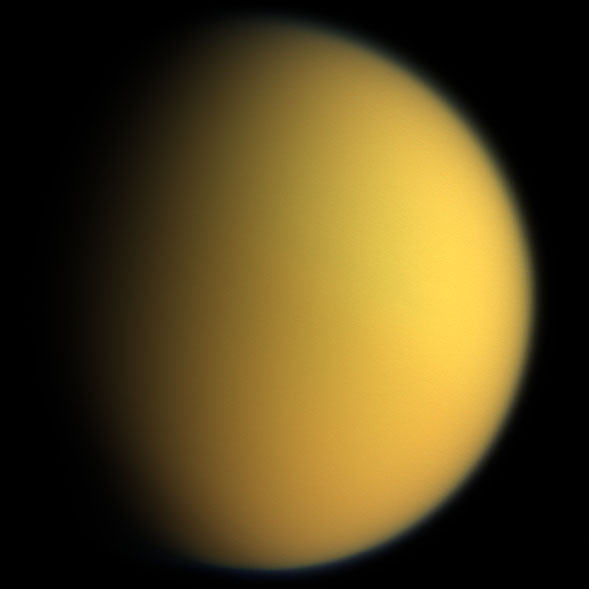The Cassini spacecraft has made measurements of how much Saturn's moon Titan changes shape each time it circles Saturn, uncovering strong new evidence for liquid water beneath the moon's surface.
Writing in the journal Science, Luciano Iess and his colleagues measured how much Titan deforms on each orbit due to the tides it feels from Saturn's gravitation field - the fact that Saturn's gravitational field is stronger on the side facing its parent planet than on the far side.
Their paper models Titan as if it were an elastic ball that is compressed by these tides, and because Titan's orbit isn't perfectly circular, its distance from Saturn changes over the course of each orbit, and the degree of compression changes.
Using this to measure Titan's elasticity gives clues as to what the moon is made of and what lies beneath its surface. Crucially, Iess's team argues that the amplitude of the deformation is so large - around 10 metres - that Titan appears far more elastic than any known rock. That suggests the presence of a liquid layer beneath the surface which is able to flow on a global scale.
 Speaking to me this week from the University of Rome where he is based, Iess explained the effect by using the Earth as a point of comparison.
Speaking to me this week from the University of Rome where he is based, Iess explained the effect by using the Earth as a point of comparison.
"In addition to the [Earth's] ocean tides, also the crust of the Earth deforms with tides which have an amplitude of around 40cm", he explains, adding that the deformation could only be this large because the Earth has liquid magma which is able to flow beneath its surface.
"If Titan were completely solid - made completely of rocks - it would not be deformed much. While we have seen tides that correspond to a deformation of around 10m, if Titan were completely solid, the deformation would have been maximum one metre".
His conclusion is that Titan too must have a liquid beneath its surface, and the measured elasticity is a good match to the viscosity and density of free-flowing liquid water.
These measurements are the culmination of data collected over several years. The Cassini spacecraft has been orbiting Saturn since 2004, and has made six close fly-bys of Titan in that time. Although the deformation of Titan's surface is too small to see in photographs, it produces tiny changes in Titan's gravitational field, which in turn affected how Cassini's trajectory was deflected by Titan on each close approach. Though these changes were tiny, the positions of spacecraft are routinely monitored to such high precision that even small forces changing their paths can be identified and measured.
One of the reasons why discoveries of liquid water elsewhere in the Solar System attract particular interest is that it is almost certainly necessary for life.
According to Iess, "The discovery of water does not imply life, but it's difficult to think of life without liquid water. Titan from the point of view of astrobiology is a very interesting object, because there are hydrocarbons, there is a cycle of liquids on the surface, there is liquid water: there are all of the ingredients which are necessary to build up life."
Looking ahead, he plans to refine his measurements over the next few years using three more fly-bys of Titan scheduled before Cassini is decommissioned in 2017.
There are also other moons in the Saturnian system that also warrant close inspection, in particular Enceladus. Although this is a very small moon just 200km across, geysers around its south pole provide strong evidence for pockets of liquid water beneath its surface, which may be probed by the next generation of spacecraft.









Comments
Add a comment